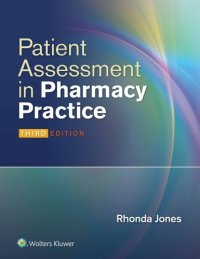
Ebook: Patient Assessment in Pharmacy Practice
Author: Rhonda M. Jones
- Genre: Medicine // Diseases
- Year: 2015
- Publisher: Wolters Kluwer / LWW
- Edition: 3rd Edition
- Language: English
- pdf
Develop the patient assessment and clinical skills you need with the Third Edition of Patient Assessment in Pharmacy Practice . The only patient assessment text in the field written specifically for pharmacy students, this practical book relates patient assessment and clinical skills to pharmacy practice. To help readers correlate signs and symptoms of possible diseases, the book includes vital information on basic anatomy and physiology, pathology, and system assessment through interview, communication, and physical exams.
Now a “one-stop shop” for assessment and clinical skills development, the companion eBook features 23 patient assessment video clips. Unlike other assessment videos that depict assessments in a doctor’s office, these videos depict assessments in pharmacist-specific practice settings.
New coverage of clinical skills makes the text a “one-stop shop” for assessment and clinical skill development.
Updated content reflects current clinical practice guidelines, clinical skills, treatment recommendations, drug-induced symptoms, etc.
Revised patient cases in each chapter illustrate the latest best practices in patient assessment.
New application activities, laboratory activities, and/or active learning suggestions are now included in each chapter.
Case studies in each chapter include interview questions, patient assessment algorithms, sample pharmaceutical care plans, and critical thinking and self-assessment questions.
Coverage of global issues related to assessment and health-related problems that span many body systems (for example, pain and nutrition) help readers broaden their understanding.
Detailed information is provided on assessment of body systems/regions (head to toe), assessment of special populations, and assessment in community and ambulatory care settings.
Body system chapters follow a consistent organization to facilitate understanding: key terms, A&P overview, pathology overview, system assessment, applications to patient systems, one or more case studies with sample pharmaceutical care plans, patient decision trees (algorithms), and self-assessment questions.
Full-color photographs and illustrations enhance understanding of different assessment techniques.
Special boxes highlight signs and symptoms of diseases, causes of diseases, and drug-induced symptoms of diseases.
Application activities, laboratory activities, and/or active learning suggestions in every chapter give readers hands-on practice.
Tables summarize important information.
Patient assessment video clips use a "head to toe" approach and demonstrate a range of pharmacist-patient encounters.
Now a “one-stop shop” for assessment and clinical skills development, the companion eBook features 23 patient assessment video clips. Unlike other assessment videos that depict assessments in a doctor’s office, these videos depict assessments in pharmacist-specific practice settings.
New coverage of clinical skills makes the text a “one-stop shop” for assessment and clinical skill development.
Updated content reflects current clinical practice guidelines, clinical skills, treatment recommendations, drug-induced symptoms, etc.
Revised patient cases in each chapter illustrate the latest best practices in patient assessment.
New application activities, laboratory activities, and/or active learning suggestions are now included in each chapter.
Case studies in each chapter include interview questions, patient assessment algorithms, sample pharmaceutical care plans, and critical thinking and self-assessment questions.
Coverage of global issues related to assessment and health-related problems that span many body systems (for example, pain and nutrition) help readers broaden their understanding.
Detailed information is provided on assessment of body systems/regions (head to toe), assessment of special populations, and assessment in community and ambulatory care settings.
Body system chapters follow a consistent organization to facilitate understanding: key terms, A&P overview, pathology overview, system assessment, applications to patient systems, one or more case studies with sample pharmaceutical care plans, patient decision trees (algorithms), and self-assessment questions.
Full-color photographs and illustrations enhance understanding of different assessment techniques.
Special boxes highlight signs and symptoms of diseases, causes of diseases, and drug-induced symptoms of diseases.
Application activities, laboratory activities, and/or active learning suggestions in every chapter give readers hands-on practice.
Tables summarize important information.
Patient assessment video clips use a "head to toe" approach and demonstrate a range of pharmacist-patient encounters.
Download the book Patient Assessment in Pharmacy Practice for free or read online
Continue reading on any device:

Last viewed books
Related books
{related-news}
Comments (0)